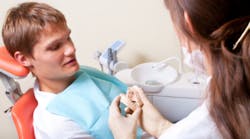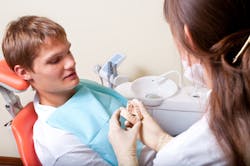Ethical dilemma: Working with unethical or neglectful hygienists
Have you ever felt your heart sink when examining a colleague's patient because you see a mouth full of decay—but there's nothing on the patient's chart? This situation should be handled carefully to preserve the patient's relationship with the practice, as well as your relationship with your colleagues.
Working with another hygienist can be an awesome cohesive partnership—or a nightmare. Every once in a while, a patient might get scheduled with a different hygienist in the same office. This is where an ethical dilemma may occur.
Consider this example
You’re treating a patient whom you have never seen, but has been a faithful patient, never missing a prophy. She presents with moderate bone loss and moderate subgingival calculus. Her periodontal issue is evident, yet there is nothing in her record from the previous hygienist—no notations, radiographs, or recommendations. The chart reads as if this patient has been faithful to her home care and has mild gingivitis with some bleeding.
The patient is looking to you for a routine prophy and an excellent bill of health, not to mention praise her for all of her flossing and brushing. If you say something, the patient may feel like you do not know what you are talking about, because the other hygienist has been telling her for years how great she is. The doctor has never said anything, either. In the patient’s eye, you would be in the wrong, since she has done everything that she was told and was praised during every visit.
How to resolve this situation positively and professionally
How do you properly educate the patient and get her on the right track without derailing the hygiene and hygienist she loves so much? Professionalism and positivity should reign in this situation. As you typically would, inform the dentist of your findings and recommendations for treatment. Allow the dentist to inform the patient so she does not think that you, the “new hygienist,” just do not know what you are talking about. This is a natural thinking pattern of a patient that has a preexisting relationship with her usual hygienist.
This situation is an extremely difficult and tricky. There are so many variables involved. Of course, the patient’s best interest trumps everything. What about the other hygienist? Maybe her passion for hygiene is diminished. Consider scheduling a large, hygiene-centered CE weekend for a pick-me-up. The office would benefit tremendously. The hygienists will get pumped up from the speaker, get the newest products on the market to try, and will be very excited to come back to the office to implement what they have learned. The patients benefit, the hygienists benefit, and the office will benefit in production.
READ MORE | Ethical dilemma: Dental hygienists who work while sick
Another way to prevent this dilemma would be a full office review of each hygiene patient in the daily huddle. The patient’s previous six to 12 months of treatment and most current x-rays could be discussed. The patient’s treatment scheduled that day as well as any treatment plan or possible treatment needed would also be discussed. This daily huddle needs to be an open, free discussion, with nothing taken personally. This way, the patient will have a team approach, and if any treatment is needed, the hygienist can discuss it with her before the doctor’s exam. This open-team huddle would also allow for the team to look back on radiographs and identify anything unusual (e.g., moderate subgingival calculus), creating an opportunity to discuss it with the treating hygienist then.
Team preparation can make potentially difficult conversations with patients go much more smoothly, or even prevent them in the first place.
Timing is everything here. Patient-, not production-focused, dentistry will ultimately drive more patients to the practice, increase production organically, and make the team work in a goal-oriented, cohesive, and respectful manner. It all boils down to teamwork, with everyone having the same goals for the patient. Without our patients, we are just an empty waiting room. Let’s fill it up by being the talk of the town through making our patients feel good and truly talking to them about dentistry. After all, they are not coming to us to talk about their shoes.
For the most current dental headlines, click here.
Editor's note: This article originally appeared in RDH eVillage Focus. Our editorial team would be happy to deliver content like this to your inbox twice a month. Just let us know by subscribing here.
Nicole Giesey, RDH, MSPTE, enjoys researching, writing, and educating on topics related to dental hygiene. She is the dental hygiene product specialist for Maxill. She can be contacted at [email protected].
About the Author

Nicole Giesey, MBA, MSPTE, BSDH, RDH
Nicole Giesey, MBA, MSPTE, BSDH, RDH, is a passionate registered dental hygienist dedicated to researching, writing, and helping others. She fell in love with the education process and has invested time in various roles to expand her knowledge of different avenues available to hygienists. She started her career as a dental assistant and then progressed into dental hygiene. She branched into dental hygiene education. With the opportunity of getting into dental product management and inside sales management knocking at her door, she leaped into the world of dental sales. She is now a dental product sales representative. She can be reached at [email protected].

